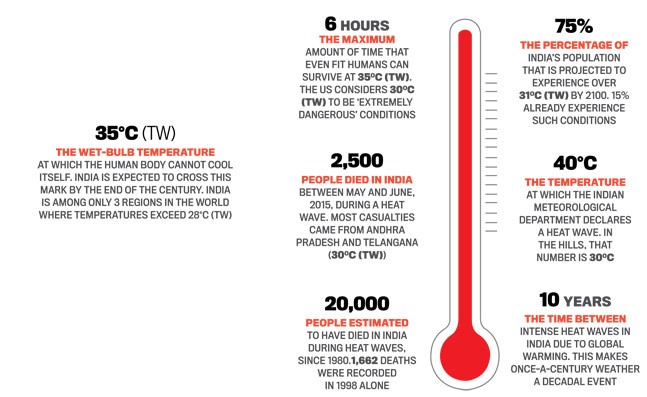Heatwaves: India
(→2001-16) |
|||
| Line 33: | Line 33: | ||
“Since the frequency of heatwaves is increasing due to climate change, we have been pursuing the implementation of heat plans with the government. Ideally local government administration or municipalities should be in charge of it,“ Mavalankar said. | “Since the frequency of heatwaves is increasing due to climate change, we have been pursuing the implementation of heat plans with the government. Ideally local government administration or municipalities should be in charge of it,“ Mavalankar said. | ||
| + | |||
| + | == 2017 == | ||
| + | [https://www.indiatoday.in/magazine/up-front/story/20170911-heat-humidity-wet-bulb-temperature-1035310-2017-09-02 India Today , The heat is on “India Today” 11/9/2017] | ||
| + | [[File: The heat is on .jpg| The heat is on |frame|500px]] | ||
| + | |||
| + | A study published this month in Science Advances, an American journal, shows that by the end of the century large parts of India may become uninhabitable due to a combination of heat and humidity. The study examined data based on rising wet-bulb temperatures (TW), a measure of the air temperature combined with humidity, to account for relatively cool days that feel hotter because of high humidity. Once a certain wet-bulb temperature is exceeded, the body can no longer cool itself. According to the study, at these temperatures, "exposure, for even a few hours will result in death even for the fittest of humans under shaded, well-ventilated conditions". | ||
=Deaths caused= | =Deaths caused= | ||
Revision as of 17:00, 23 June 2018
This is a collection of articles archived for the excellence of their content. |
Contents |
Rise in heatwaves
2001-16
The Times of India, May 21 2016
Jayashree Nandi
Rajasthan's Phalodi recorded the country's highest temperature ever of 51°C. The India Meteorological Department has said the frequency of severe heatwaves had increased sharply in the past 15 years.
Most heat-affected states have no plan in place to prevent mortality and morbidity associated with extreme heat. IMD officials said the average frequency of severe heat waves had doubled from 50 days a year across India until 2000, to about 100 in the 2001-2010 decade. The figures are cumulative numbers from all IMD stations. So, if there are 10 severe heat wave days in two cities simultaneously, it's counted as 20.
“The frequency of both heatwaves and severe heatwaves has increased, particularly in the last two decades. The reasons could be related to climate change, urban heat island effect or others,“ said B P Yadav, director, National Weather Forecasting Centre at IMD.
He added that between 2010 and 2016 too, heatwaves showed an upward trend.IMD has started issuing a separate colour-coded heat wave forecasting from this year, which alerts agencies on when interventions are required, because of what it called a “visible increase“ in both mean temperature and heat wave incidents.
IMD's observations correlate with warnings by the Intergovernmental Panel on Climate Change (IPCC) of a steady increase in warm days and nights globally, and higher temperatures in cities due to the urban heat island effect.
The Indian Institute of Public Health (IIPH), which has developed a heat action plan for Ahmedabad and helped cities in Maharashtra develop theirs, has advised the Union health ministry to ensure that similar plans are implemented in all states affected by heatwaves.
As of now Maharashtra, Gujarat, Telangana and Andhra Pradesh have started a heat action plan.
“Mortality increases as soon as there is a heatwave.For instance, on Thursday when it recorded 48 degrees in Ahmedabad, there were 130 deaths compared to 100 deaths daily on an average.During the 2010 heat wave, there were 310 deaths in a day and about 800 deaths in total in the following week,“ said Dr Dileep Mavalankar, director, IIPH, Gandhinagar.
“Since the frequency of heatwaves is increasing due to climate change, we have been pursuing the implementation of heat plans with the government. Ideally local government administration or municipalities should be in charge of it,“ Mavalankar said.
2017
India Today , The heat is on “India Today” 11/9/2017
A study published this month in Science Advances, an American journal, shows that by the end of the century large parts of India may become uninhabitable due to a combination of heat and humidity. The study examined data based on rising wet-bulb temperatures (TW), a measure of the air temperature combined with humidity, to account for relatively cool days that feel hotter because of high humidity. Once a certain wet-bulb temperature is exceeded, the body can no longer cool itself. According to the study, at these temperatures, "exposure, for even a few hours will result in death even for the fittest of humans under shaded, well-ventilated conditions".
Deaths caused
2013-16

The Times of India, April 27, 2016
87 deaths take heatwave toll since 2013 to 4,204 As many as 87 people died between January and March 2016 owing to a heatwave, with the first three months of 2016 experiencing significantly abovenormal temperatures.
At 56, Telangana recorded the maximum casualties, followed by Odisha (19).Maharashtra, Tamil Nadu, Karnataka and Kerala witnessed one heatwave casualty each.
The deaths in 2013 take India's heatwave toll since 2013 to a staggering 4,204. In 2013, 2014 and 2015, heatwave killed 1,433, 549, and 2,135 peo ple, respectively. The figures were shared by earth sciences minister Y S Chowdary in the Lok Sabha on Wednesday in a written response to a question asked by over nine parliamentarians.
The number may go much higher if states do not take adequate precautionary me asures, as advised by IMD, in view of a forecast of higherthan-average temperatures for this year's summer (April-June). “Above normal heatwave conditions are very likely over central and north-west India during the 2016 hot weather season,“ Chowdary said.
